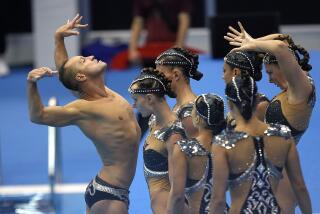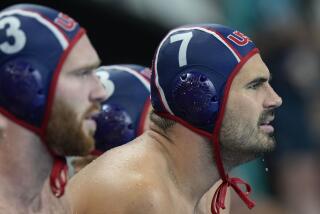SWIMMING : Olympians to Get Time to Breathe
- Share via
It has long been said, only somewhat in jest, that the U.S. Olympic trials constitute the toughest swim meet in the world.
Just ask Andy Coan. The world record-holder in the 100-meter freestyle in 1975, he did not qualify for the Olympic team in 1976. For that matter, he didn’t make the eight-man field for the trials final.
The limit on entries, two per event, and the depth of U.S. swimming conspire to make the U.S. trials more difficult than the Olympic Games themselves.
That is expected to change at the U.S. Swimming Convention in Pittsburgh next week when the 600-member House of Delegates votes to confirm March 1-6 as the dates for the 1992 U.S. Olympic trials.
Previously, the U.S. team was selected only three or four weeks before the Olympic Games. The March dates, an adaptation of the Australian system, will give the team almost four months of training together before the 1992 Games in Barcelona, Spain.
The problem with the old system, some coaches believed, was that to make the highly competitive U.S. team, swimmers were tapering--easing up on their training and shaving their body hair--for the trials, then repeating the process a few weeks later for the Olympic Games.
The second time, many believe, the taper doesn’t take as effectively.
“It takes such a big effort just to make the team and then we were asking them to bounce back for the Games a month later,” said Doug Ingram, date selection chairman. “It’s tough to come off that emotional high from the trials that quickly.”
But some coaches contend that the early selection process penalizes the “hot” swimmer, the one who peaks at the trials and continues to pick up speed through the Olympics.
Ingram believes that sacrifice will have to be made.
“We feel what’s best for the group outweighs the potential loss of an individual who comes on at the last minute,” he said.
The new system also has a major impact on collegiate swimming, since the trials will be held three to four weeks before the women’s and men’s NCAA Division I championships.
“It’ll take some focus away from the NCAA championships, but what came across in our meetings with college and club coaches is that in an Olympic year they are willing to put aside their local concerns and put the focus on the national concern,” said Ingram, who coaches the men’s team at Southern Illinois University.
The conference championship meets will be affected even more, since potential Olympians won’t taper for them. Instead, they will train hard up to and during the conference meets so that they can taper before the Olympic trials.
As a result, some conferences, including the Pac-10 and the Southeastern, are considering moving their conference meets from March, 1992, to December, 1991.
“That takes the pressure off an individual who might feel that he was letting his team down by focusing on the Olympic trials,” Ingram said.
The system will be tested in January. For the first time, the U.S. picked a national team several months in advance. The World Championships team was selected in early August and will compete Jan. 7-11 in Perth, Australia.
When the Mission Bay swimming program appeared on the scene in 1985 by hiring away Mark Schubert from the Mission Viejo Nadadores, it appeared to be patterning itself after a Nadador program that had won 44 national team titles. The club, in Boca Raton, Fla., had the facilities, the funding and the coaching to attract swimmers from all over the country.
Just two years later, it lost Schubert to the University of Texas women’s program and the affiliated Longhorn club. Now his successor, Steve Bultman, an assistant on the 1988 Olympic team, is gone.
“I still think Mission Bay is probably the best training facility in the country, but I do think coaching changes have not had a stabilizing effect,” Schubert said. “It is not on as solid a footing as it appeared to be at the beginning. The budget cuts have hurt. It never lived up to the dream it was supposed to be.”
Schubert’s Longhorn club is up to 250 members, an increase of 40. More swimmers are expected with the recent addition of a satellite facility, a 50-meter pool in the Circle C section of Austin.
Swimming Notes
Indianapolis, Nashville, Orlando, Fla., and Oklahoma City are vying to be the host of the 1992 Olympic trials, although late bids will be accepted before the voting at the U.S. Swimming convention Sept. 23 in Pittsburgh. . . . Voting will be held there for performance of the year. Tom Jager and Mike Barrowman, the only U.S. swimmers to set world records in 1990, appear to be the best bets. Jager, the former UCLA star, lowered the 50-meter freestyle mark twice on March 24 in Nashville with a final clocking of 21.81 seconds. Barrowman bettered the mark he set in August 1989 in Tokyo by a whopping 1.36 seconds, the most improvement of the 200 breaststroke record since 1976. . . . Finalists for swimmer of the year are Barrowman, Jager, Matt Biondi , Janet Evans, Melvin Stewart, Eric Namesnik, Leigh Ann Fetter and Nicole Haislett. Jon Urbanchek of the University of Michigan, formerly coach at Cal State Long Beach, was named coach of the year by the American Swimming Coaches Assn. at itsconvention last week in Washington. Urbanchek is credited with having developed Barrowman. . . . Olympic gold medalist Mark Spitz is at the Olympic Training Center in Colorado Springs, Colo., for tests at the International Center for Aquatic Research. Spitz plans to swim in the flume, the only swimming treadmill in the Western Hemisphere. His stroke efficiency and swimming economy, a gauge of how efficiently he uses oxygen, will be measured and compared to future tests. . . . On Saturday, Spitz and members of Indiana’s six NCAA championship teams, 1968 through ‘73, will meet in Bloomington, Ind., for a reunion.
More to Read
Go beyond the scoreboard
Get the latest on L.A.'s teams in the daily Sports Report newsletter.
You may occasionally receive promotional content from the Los Angeles Times.






